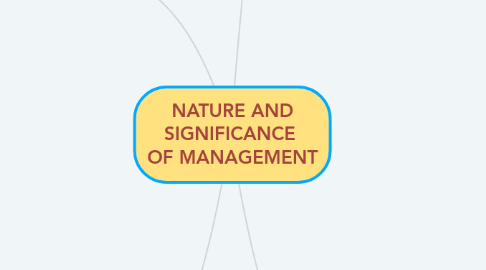
1. Objectives of Management
1.1. Organisational Objectives
1.1.1. Survival
1.1.1.1. Organisation must earn enough revenues to cover costs.
1.1.2. Profit
1.1.2.1. For covering costs and risks of the business.
1.1.2.2. Provides a vital incentive
1.1.3. Growth
1.1.3.1. To remain in the industry, management must exploit fully the growth potential of the organisation.
1.1.3.2. EG. sales volume increase in the number of employees, the number of products or the increase in capital investment, etc.
1.2. Social objectives:
1.2.1. Business or non-business, has a social obligation to fulfill
1.2.2. EG. using environmental friendly methods of production, giving employment opportunities to the disadvantaged sections
1.2.3. EG. providing basic amenities like schools and crèches to employees
1.3. Personal objectives
1.3.1. People who have different personalities, backgrounds, experiences and objectives
1.3.1.1. Financial needs
1.3.1.1.1. Competitive salaries and perks
1.3.1.2. Social needs
1.3.1.2.1. Peer recognition and higher level needs such as personal growth and development.
1.3.2. Reconcile personal goals with organisational objectives
2. Importance of Management
2.1. Management helps in achieving group goals
2.1.1. Task of a manager is to give a common direction to the individual effort in achieving the overall goal of the organisation
2.2. Management increases efficiency
2.2.1. Aim is to reduce costs and increase productivity through better planning, organising, directing, staffing and controlling
2.3. Management creates a dynamic organisation
2.3.1. Helps people adapt to changes so that the organisation is able to maintain its competitive edge
2.3.2. Individuals resist change as it often means moving from a familiar, secure environment into challenging one
2.4. Management helps in achieving personal objectives
2.4.1. Motivates and leads team so that individual are able to achieve personal goals while contributing to the overall organisational objective
2.4.2. Helps individuals to develop team spirit, cooperation and commitment
2.5. Management helps in the development of society
2.5.1. Organisation has multiple objectives
3. MEANING
3.1. Process of getting things done with the aim of achieving goals effectively and efficiently
3.1.1. Efficiency
3.1.1.1. Doing the task orrectly and with minimum cost
3.1.1.2. Cost-benefit analysis involved and the relationship between inputs and outputs
3.1.1.3. EX. Cuts down cost but not achieving the target production of 5000 units Goods do not reach the market in time
3.1.2. Effectiveness
3.1.2.1. Doing the right task, completing activities and achieving goals.
3.1.2.2. Concerned with the end result
3.1.2.3. EX. Manager is able to produce 5000 units but at a higher production cost
3.1.3. Management has to achieve goals (effectiveness) with minimum resources i.e., as efficiently as possible while maintaining a balance between effectiveness and efficiency.
4. Characteristics of Management
4.1. Goal-oriented
4.1.1. Basic goals which are the basic reason for its existence
4.1.2. SMART
4.1.3. EX. retail- increase sales, Spastics Society of India - impart education to children with special needs
4.2. Pervasive
4.2.1. Common to all organisations whether economic, social or political.
4.2.2. EX. A petrol pump , a hospital or a school
4.2.3. Managers in India, the USA, Germany or Japan manage but differences in culture,tradition and history
4.3. Multidimensional
4.3.1. Management of work
4.3.1.1. performance of some work
4.3.1.2. translates this work in terms of goals to be achieved and assigns the means to achieve it
4.3.1.3. done in terms of problems to be solved, decisions to be made, plans to be established, budgets to be prepared,
4.3.2. Management of operations
4.3.2.1. production process - flow of input material and technology- transforming input into the desired output
4.3.3. Management of people
4.3.3.1. greatest asset.
4.3.3.2. deal with employees as individuals with diverse needs and behavior; deal with individuals as a group of people
4.3.3.3. Employees strengths effective and weaknesses irrelevant
4.4. Continuous
4.4.1. Series of continuous, composite, but separate functions (planning, organising, directing, staffing and controlling
4.4.2. Functions are simultaneously performed by all managers all the time.
4.4.3. EX. Some days Suhasini may spend more time in planning a future exhibition and on another day she may spend time in sorting out an employee’s problem
4.5. group activity
4.5.1. Organisation is a collection of diverse individuals with different needs.
4.5.2. Every member has a different purpose for joining, but they work towards fulfilling organisational goal
4.5.3. Enable all its members to grow and develop as needs and opportunities change
4.6. Dynamic function
4.6.1. Adapt itself to the changing environment
4.6.2. Environment consists of social, economic ,legal, technological and political
4.6.3. EX. McDonalds, the fast food giant made major changes in its menu to be able to survive in the Indian market.
4.7. Intangible force
4.7.1. Force that cannot be seen but its presence can be felt in the way the organisation functions
4.7.2. EX. where targets are met according to plans, employees are happy and satisfied, and there is orderliness instead of chaos
